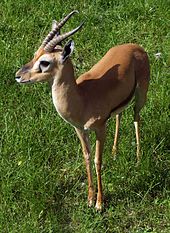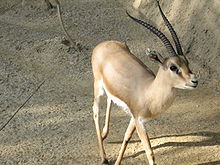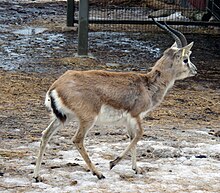Gazelles
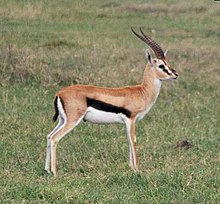
The gazelles (from Italian gazzella , from Arabic غزال ghazāl , DMG ġazāl ) are in the narrower sense a group of horned bearers (Bovidae) that are mainly found in the savannahs and desert regions of Africa and Asia . This group currently comprises more than 30 species , which are now listed in four genera ( Eudorcas , Gazella , Nanger and Antilope ). In a broader sense, the entire genus group of gazelle-like is sometimes referred toas gazelles.
features
Gazelles are slender, long-legged animals. They reach head body lengths of 85 to 170 centimeters, plus a 15 to 30 centimeter long tail. The shoulder height is between 50 and 110 centimeters and the weight between 12 and 85 kilograms. The fur is colored yellowish-gray to brown on the upper side and on the flanks, the underside is white. In many species, a black stripe extends along the trunk, which is accompanied by an overlying light stripe.
Usually both sexes have horns, even if those of the females are shorter and more delicate - only in the crop gazelle only the males have horns. The horns are on average 25 to 35 centimeters long.
distribution and habitat
The range of the gazelles covers the whole of Africa (excluding Madagascar ) and large parts of Asia (from the Arabian Peninsula to northern India and northern China ). Their habitat are dry, open regions, mostly grass steppes, with some species also deserts and semi-deserts.
Way of life
The female gazelles live with their young in herds of ten to thirty animals; however, the herd size in the African savannah can also include hundreds or even thousands of individual animals. Male gazelles live in their own bachelor herds in the first few years of life before they become territorial. Then they claim all females who enter their territory, which they defend against competing males.
All gazelles are fast runners who can maintain speeds of 50 km / h for a long time. Top speeds of 80 km / h are known from the Thomson Gazelle.
Gazelles are herbivores that feed on various grasses and herbs.
species
|
Internal systematics of the Antilopini according to Zurano et al. 2019
|
The internal system and the exact number of species of the gazelles is not fully clarified. Modern classifications divide the gazelles of the original genus Gazella into three genera ( Gazella , Eudorcas and Nanger ) and distinguish over 30 species, in older classifications, however, these genera were still sub-genera of the genus Gazella . The genera Gazella , Eudorcas and Nanger form together with the stag goat antelope ( Antilope cervicapra ) a monophyletic group, whereby further genetic studies indicate that the genus Antilope could be within Gazella . The short-tailed gazelles ( Procapra ), which were also previously classified as a subgenus of Gazella , represent a branch of their own (the following system follows Wilson & Reeder, 2005 and also refers to the revision by Groves and Grubb 2011 in which many former subspecies were granted species status) :


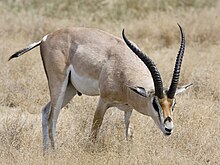
- Genus Antelope Pallas , 1766
- In the stag goat antelope ( Antilope cervicapra ( Linnaeus , 1758)) only the males have horns, the females are hornless.
-
- The Mongalla gazelle ( Eudorcas albonotata ( W. Rothschild , 1903)) is native to the savannahs and alluvial lands of South Sudan. Sometimes it is regarded as the shape of the Thomson gazelle or together with this as the shape of the red-fronted gazelle.
- The red-fronted gazelle ( Eudorcas rufifrons ( Gray , 1846)) is common in the savannas of West Africa. Their fur is light brown with a narrow, black stripe on the flank. It is named after a reddish brown spot on the forehead.
- The Algerian gazelle ( Eudorcas rufina ( Thomas , 1894)) has become extinct. Three museum specimens still bear witness to this gazelle from the Atlas Mountains, which had a dark red fur. The last Algerian gazelle was probably shot in 1894.
- Heugelin gazelle ( Eudorcas tilonura ( Heuglin , 1869)) Native to the Ethiopian-Sudanese border area, it is also seen as a subspecies of the red-fronted gazelle.
- Of all the gazelles, the Thomson gazelles ( Eudorcas thomsonii species complex), named after the Scottish African explorer Joseph Thomson , are the most common. They are common with two types in Tanzania and Kenya . About 1 million specimens live in the East African savannahs. Thus the Thomson's gazelles are after the wildebeest are the most common ungulates of the Serengeti . Individual herds often consist of several thousand animals. The gazelles play an important role in the Serengeti ecosystem. Adult Thomson's gazelles reach speeds of up to 80 km / h and can usually escape attackers - with the exception of the cheetah . Sometimes the shapes of the Thomson gazelle are summarized as a subspecies of the red-fronted gazelle.
- Western Thomson's gazelle ( Eudorcas nasalis ( Lönnberg , 1908)) northern Tanzania as far as Kenya z. B. in the Serengeti and in the Ngorongoro Crater.
- Eastern Thomson's gazelle ( Eudorcas thomsonii ( Günther , 1884)) Southern Kenya and Tanzania east of the East African Rift in the Nairobi and Kilimanjaro regions, the Wembere steppe and Shinyanga.
-
- Genus Gazella de Blainville , 1816
-
- Gazella subgutturosa group
- The threatened Cuvier's gazelle ( Gazella cuvieri ( Ogilby , 1841)) only lives in a few valleys of the Atlas Mountains . Around 1500 to 2500 of these gazelles are still alive today.
- Turkmenistan goiter gazelle ( Gazella gracilicornis Stroganov , 1956)
- The dune gazelle ( Gazella leptoceros ( Cuvier , 1842)) is a gazelle adapted to life in the Sahara with a creamy white fur and extremely slender horns. The hooves are widened to avoid sinking into the sand. To avoid the heat, the dune gazelle is nocturnal. She does not need to drink, but meets all her fluid requirements from food. The IUCN classifies the dune gazelle as critically endangered.
- Sand gazelle ( Gazella marica Thomas , 1897)
- The crop gazelle ( Gazella subgutturosa ( Güldenstädt , 1780)) is a specialty among the gazelles, as only the males have horns and the females are hornless. In all other gazelles, both sexes have horns. The distribution area extends from Azerbaijan over the east of the Arabian Peninsula, Iran, Afghanistan and Pakistan in the north-west of India as well as over Uzbekistan and Xinjiang to Mongolia and Manchuria. In this large area it inhabits deserts, semi-deserts and steppe areas.
- Jarkand goiter gazelle ( Gazella yarkandensis Blanford , 1875)
- Gazella dorcas group
- The Dorcas gazelle ( Gazella dorcas ( Linnaeus , 1758)) was considered a typical gazelle before the animal world of the East African savannahs became well known with the Thomson and Grant gazelles. Their distribution area covers North Africa south to the Sahel zone.
- The furry gazelle ( Gazella pelzelni Kohl , 1886) is also considered a subspecies of the Dorcas gazelle.
- The extinct Saudi gazelle ( Gazella saudiya Carruthers & Schwarz , 1935) was once widespread from Kuwait and Saudi Arabia to Yemen . Excessive hunting made it extinct in the mid-20th century. There are still some specimens in zoos; according to recent studies, however, they are exclusively hybrids with other gazelle species.
- Gazella gazella group
- Acacia Gazelle ( Gazella acaciae Mendelssohn, Groves & Shalmon , 1997) in Southern Israel; this is apparently a relic population that was isolated in the Arawa Valley north of Eilat after the end of the Ice Age . In the 1950s several hundred gazelles lived here on an area of 7.5 km². Due to the diversion of bodies of water, this valley was no longer adequately supplied with water, which triggered mass extinction. Today there are still about twenty of these gazelles. They are strictly protected, but are also subject to hunting by wolves and jackals.
- "Arabian Gazelle" ( Gazella arabica ( Lichtenstein , 1827)) The description is based on a male specimen that is said to have been shot around 1825 and is now in Berlin. In 2012, DNA analyzes revealed that the fur and skull of this specimen come from representatives of two evolutionary lines of the real gazelle ( Gazella gazella ) and that this assumed species or subspecies therefore never existed.
- † Yemen Gazelle ( Gazella bilkis Groves & Lay , 1985) Named after the Queen of Sheba in the Koran ( called Bilkis there). In 1951 five specimens were shot in the mountains near the city of Ta'izz . The species was previously unknown, and it has never been sighted since. The five stuffed specimens are in the Chicago Museum of Natural History .
- Arabian desert gazelle ( Gazella cora ( CH Smith , 1827)) in Saudi Arabia and Oman; extinct in Yemen. Around 10,000 animals are still alive, 90% of them in Oman. The population continues to decrease rapidly due to hunting (25% decrease from 1996 to 2003). Endangered.
- Farrur gazelle ( Gazella dareshurii Karami & Groves , 1993)
- Arabian coastal gazelle or Neumann's gazelle ( Gazella erlangeri Neumann , 1906).
- The real gazelle or Edmigazelle ( Gazella gazella ( Pallas , 1766)) once had a wide distribution from Egypt across the Middle East to the Arabian Peninsula. It has been exterminated in Syria, Jordan and Egypt. After a foot-and-mouth disease outbreak dropped her populations to 3,000, it was classified as threatened. It is strictly protected in Israel.
- Bushir gazelle ( Gazella karamii Groves , 1993)
- Muscat gazelle ( Gazella muscatensis Brooke , 1874) in the northern coastal region of Oman; road construction and urban sprawl made these gazelles extremely rare; their stock was last below a hundred.
- The Spekegazelle ( Gazella spekei Blyth , 1873) is largely restricted to Somalia ; occasionally the animals also migrate over Ethiopian territory. This gazelle lives in stony semi-deserts. It has a beige-brown fur with a black stripe on the flank. As a special feature, Spekega's cells have a cross fold in the skin over the bridge of the nose. As an alarm call, you can inflate your nose to the size of a tennis ball. When the air is released, it makes a sound like a pistol shot. Species gazelles are classified as critically endangered by the IUCN, but their actual status is hardly known. They are named after the British Africa explorer John Hanning Speke .
- Gazella Bennetti Group
- The Indian gazelle or Dekkan chinkara ( Gazella bennettii ( Sykes , 1831)) is common in southern Iran, Pakistan and northern India. While it has become very rare, especially in Pakistan, there are still around 10,000 gazelles of this species in Indian and Iranian protected areas.
- The Gujarat Chinkara ( Gazella christii Blyth , 1842) western India and southern Pakistan; is also considered a subspecies of the Indian gazelle.
- The Baluchistan Chinkara ( Gazella fuscifrons Blanford , 1873) eastern Iran, southern Afghanistan, Pakistan, northwestern India; is also considered a subspecies of the Indian gazelle.
- The Punjab Chinkara or Rajasthan Gazelle ( Gazella salinarum Groves , 2003) northwestern India and eastern Pakistan; is also considered a subspecies of the Indian gazelle.
- The Iran Chinkara or Shikari Gazelle ( Gazella shikarii Groves , 1993) northwestern Iran; is also considered a subspecies of the Indian gazelle.
-
- The Damagazelle ( Nanger dama ( Pallas , 1766)) is very variable in color. The eastern populations are patterned brown and white, while the western Damaga cells are almost red. However, all Dama cells have a white spot on the throat that can be used to identify them. The distribution area extends over the southern edge of the Sahara in the states of Mali, Niger, Chad and Sudan. Here they undertake seasonal hikes between the desert and the Sahel zone. The meaning of the name is controversial. While some trace the name back to the fallow deer (Latin dama ), others see the Arabic dammar ("sheep") as part of the name.
- The summer ring gazelle ( Nanger soemmerringii ( Cretzschmar , 1826)) is a gazelle with a beige upper and white underside. The head drawing is characteristic: a broad black stripe runs from the nose to the forehead and is lined with two narrow white stripes. The distribution area includes steppes and semi-deserts in Sudan, Ethiopia, Eritrea and Somalia. This gazelle is named after the German scientist Samuel Thomas Sömmerring .
- The Grant gazelles ( Nanger granti species complex) are the most common gazelles after the Thomson gazelles. This is especially true of the populations in Kenya, Tanzania, and Uganda, while the northern populations are much smaller in Ethiopia, Sudan, and Somalia. 350,000 Grant gazelles live in the savannahs of East Africa, where they form herds that can number several hundred animals. The fur is beige-brown on top and white on the underside. Sometimes there is a black flank stripe in contrast to the Thomson gazelle, but there is an area with beige-brown fur between the black stripe and the white area. The Grant's gazelle, which was originally regarded as uniform, is now split into three species.
- Southern Grant's gazelle ( Nanger granti ( Brooke , 1872)); mostly there is no black flank stripe in males, in females it is pale, horns bent outwards and tips often bent backwards.
- Northern Grant's gazelle ( Nanger notatus ( Thomas , 1897)); black flank stripes mostly pale in both sexes, horn tips bent forward.
- Eastern Grant's gazelle ( Nanger petersii ( Günther , 1884)); in males there is no black flank stripe, horns strikingly straight and tips bent forward
-
Prehistoric species
- European gazelle ( Gazella borbonica )
- Gazella praethomsoni
- Gazella negevensis
- Gazella triquetrucornis
- Gazella capricornis
- Gazella mytilinii
- Subgenus Vetagazella
- Gazella sinensis
- Gazella deperdita
- Steppe Gazelle ( Gazella pilgrimi )
- Leiles Gazelle ( Gazella leile )
- Japanese gazelle ( Gazella praegaudryi )
- Gazella gaudryi
- Gazella paotehensis
- Gazella dorcadoides
- Gazella altidens
- Gazella mongolica
- Gazella lydekkeri
- Gazella blacki
- Gazella parasinensis
- Gazella kueitensis
- Gazella paragutturosa
- Subgenus Gazella
- Gazella Janenschi
- Subgenus Trachelocele
- Atlantic gazelle ( Gazella atlantica )
- Gazella tingitana
- Subgenus Nanger
- Gazella vanhoepeni
- Subgenus Deprezia
- Gazella psolea
supporting documents
- ↑ See Duden: The dictionary of origin , 3rd edition 2001
- ↑ Juan P. Zurano, Felipe M. Magalhães, Ana E. Asato, Gabriel Silva, Claudio J. Bidau, Daniel O. Mesquita and Gabriel C. Costa: Cetartiodactyla: Updating a time-calibrated molecular phylogeny. Molecular Phylogenetics and Evolution 133, 2019, pp. 256-262.
- ^ Eva Verena Bärmann, Gertrud Elisabeth Rössner and Gert Wörheide: A revised phylogeny of Antilopini (Bovidae, Artiodactyla) using combined mitochondrial and nuclear genes. Molecular Phylogenetics and Evolution 67 (2), 2013, pp. 484-493 doi: 10.1016 / j.ympev.2013.02.015 .
- ↑ Halina Cernohorska, Svatava Kubickova, Olga Kopecna, Miluse Vozdova, Conrad A Matthee and Terence J Robinson: Nanger, Eudorcas, Gazella, andAntilopeform a well-supported chromosomal clade within Antilopini (Bovidae, Cetartiodactyla). Chromosoma 124 (2), 2015, pp. 235-247 doi: 10.1007 / s00412-014-0494-5 ( researchgate.net ).
- ^ A b Colin P. Groves and David M. Leslie Jr .: Family Bovidae (Hollow-horned Ruminants). In: Don E. Wilson and Russell A. Mittermeier (eds.): Handbook of the Mammals of the World. Volume 2: Hooved Mammals. Lynx Edicions, Barcelona 2011, ISBN 978-84-96553-77-4 , pp. 444-779.
- ↑ Colin Groves and Peter Grubb: Ungulate Taxonomy. Johns Hopkins University Press, 2011, pp. 1-317 (pp. 158-175).
- ^ Eva Verena Bärmann, Saskia Börner, Dirk Erpenbeck, Gertrud Elisabeth Rössner, Christiana Hebel, Gert Wörheide: The curious case of Gazella arabica. Mammalian Biology in Press (available online since August 31, 2012).
- ^ Eline D. Lorenzen, Peter Arctander and Hans R. Siegismund: Three reciprocally monophyletic mtDNA lineages elucidate the taxonomic status of Grant's gazelles. Conservation Genetics 9, 2008, pp. 593-601.
literature
- Colin Groves and Peter Grubb: Ungulate Taxonomy. Johns Hopkins University Press, 2011, pp. 1-317 (pp. 158-175).
- Colin P. Groves and David M. Leslie Jr .: Family Bovidae (Hollow-horned Ruminants). In: Don E. Wilson and Russell A. Mittermeier (eds.): Handbook of the Mammals of the World. Volume 2: Hooved Mammals. Lynx Edicions, Barcelona 2011, ISBN 978-84-96553-77-4 , pp. 444-779.
- Don E. Wilson , DeeAnn M. Reeder (Eds.): Mammal Species of the World . 3rd edition. The Johns Hopkins University Press, Baltimore 2005, ISBN 0-8018-8221-4 .
- Ronald M. Nowak: Walker's Mammals of the World . The Johns Hopkins University Press, Baltimore 1999, ISBN 0-8018-5789-9 .

